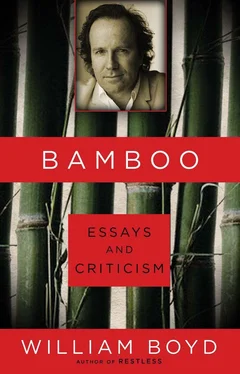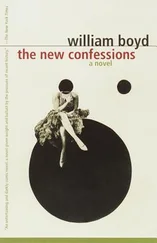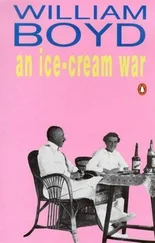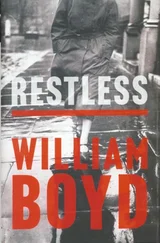Q. Quinine
At Melikhovo Chekhov had two dachshunds which he called Quinine and Bromine. Quinine was his favourite. The most natural and unposed photographs of Chekhov show him sitting on the steps of his veranda with Quinine tucked under his arm.
R. Real Lives
Chekhov said: “Every person lives his real, most interesting life under the cover of secrecy.” By this I take him to mean that other people are fundamentally opaque, mysterious — even people you know very well, your wife or husband, your family. Janet Malcolm, who has written a profound and insightful book on Chekhov (called Reading Chekhov), says that “We never see people in life as clearly as we see the people in novels, stories and plays; there is a veil between ourselves and even our closest intimates, blurring us to each other.” This, it seems to me, is the great and lasting allure of all fiction: if we want to know what other people are like we turn to the novel or the short story. In no other art form can we take up residence in other people’s minds so effortlessly. Chekhov tells us a great deal about his characters but, however, resists full exposure: there always remains something “blurry,” something secret about them. This is part of his genius: this is what makes his stories seem so real.
S. Aleksei Suvorin
A vastly wealthy, right-wing publisher and newspaper magnate and probably Chekhov’s closest male friend. Chekhov achieved a bond with Suvorin which is hard to explain, given the latter’s rebarbative politics. It’s rather as if George Orwell’s best friend had been, say, Julius Streicher. I suspect Suvorin functioned as something of a surrogate father for Chekhov (he was twenty years older) — also he paid him well and Chekhov’s fame largely came about through his stories appearing in Su-vorin’s publications. Suvorin had no illusions about Chekhov: “… a man of flint and a cruel talent with his harsh objectivity. He’s spoilt, his amour propre is enormous.” They fell out, finally, irrevocably, over the Dreyfus affair. Chekhov was an ardent Dreyfusard; Suvorin unashamedly anti-Semitic. There was no rapprochement and Suvorin bitterly regretted the rift. Asked about his politics once, Chekhov declared that he wanted only to be a “free artist.” Like Vladimir Nabokov, he was deeply distrustful of fiction that openly proselytized for any political ideology. Chekhov’s view of the human condition, given his own terminal illness, was bleakly clear-eyed. “After youth comes old age; after happiness, un-happiness, and vice versa; nobody can be healthy and cheerful all their lives… you have to be ready for anything. You just have to do your duty as best as you can.”
T. Theatre
Chekhov was both drawn to and exasperated by the theatre. He wrote his first plays purely as a way of making quick money. One always feels that he was somewhat amazed at the acclaim his later plays achieved. Seen in the light of the mature stories, the plays are clearly heavily indebted to the fiction in their mood, themes and settings — which is what made them so revolutionary and, later on, so influential. But the plays lack the seamless authority of the fiction: there are great characters, wonderful scenes, tremendous passages, moments of acute melancholy and sagacity but the parts appear greater than the whole. Perhaps only in The Cherry Orchard does everything fuse and the drama takes on an autonomy of its own. Days before his death he conceived the idea for a play about passengers stranded on an ice-bound ship. Perhaps his premature death makes the plays that Chekhov never wrote the real loss. The stories are fully achieved: a genuine apotheosis.
U. Uncle Vanya
Tolstoy went to see Uncle Vanya and loathed it. Chekhov was backstage and asked what Tolstoy’s opinion was. A kindly interlocutor said that the great man hadn’t “really understood” the play. Chekhov saw through that one. But then he was told that even though Tolstoy hadn’t enjoyed Uncle Vanya, that he thought Chekhov was an appalling playwright, he was not as bad as Shakespeare. Chekhov found this delightfully, hilariously amusing.
V. Vanity
Chekhov was six foot one inch tall — a very tall man for the end of the nineteenth century. He was handsome: in early photos he looks burly and strangely Asiatic. The familiar images of his last decade, goateed, with pince-nez, slimmed by his illness, carefully dressed, testify to a man who was proud of his appearance and knew he was attractive to women. He had a terror of going bald.
W. Writers
Chekhov wrote in a letter to Suvorin, “Remember, that writers whom we call great or just good and who make us drunk have one common, very important feature: they are going somewhere and calling you with them, and you feel not with your mind, but your whole being, that they have a goal, like the ghost of Hamlet’s father.” He also said: “Writers must be as objective as a chemist.”
X. X-rays
An X-ray of Chekhov’s lungs early in his life (had such a thing been available) would have shown the shadowy traces of the “tubercules”: latent walled-in lesions of the bacillus Mycobacterium tuberculosis. Chekhov probably caught the disease in childhood. And he saw his brother Kolia die of it in 1889. Moreover, Chekhov was a doctor: he knew exactly what was in store for him. The bacilli lie dormant in the body, kept at bay by the immune system. At moments when the immune system is under stress or weakened the bacilli break out of the tubercules and begin to spread extensively in the lungs. The lung tissue is then effectively eaten by the bacilli — consumed — hence the nineteenth-century name for the disease: “consumption.” In Chekhov’s time — the pre-antibiotic era — the only cure was isolation, rest and good nutrition. In the last years of his life Chekhov’s lungs became increasingly devastated. The amount of lung tissue available for the exchange of gases in the breathing process radically decreased. Chekhov died of breathing failure, exhaustion and general toxaemia (the tuberculosis had also spread to the spine).
Y. Yalta
A popular resort much favoured by tubercular patients. Positioned in the Crimea on the Black Sea it had a congenial climate. Chekhov moved there in 1899 and built a house, only returning to Moscow in the summer. The fact that he had taken up residence made the resort instantly chic — other invalids suddenly wanted to convalesce there rather than anywhere else — something that he doubtless found wryly amusing. His famous story “The Lady with the Dog” is set in the town. Many of Yalta’s transient lady visitors fancied themselves as the model for Anna, the eponymous heroine. Chekhov’s Yalta house is now a museum, its furnishings and decor theoretically unchanged since Chekhov lived there.
Z. Zoo
About a month before he died, the desperately ill Chekhov visited Moscow zoo. Chekhov loved animals. Apart from his dachshunds and the livestock on his estate he also had as pets two mongooses and, in Yalta, a tame crane. Conceivably, during that visit to Moscow zoo, Chekhov might have seen a cheetah in its cage. Donald Rayfield, Chekhov’s best and definitive biographer, speculates that Chekhov’s sexuality was like that of the cheetah. The male cheetah can only mate with a stranger. When the male cheetah mates with a female cheetah familiar to him he is — bizarrely — impotent. It’s a fanciful image but one worth contemplating: the dying Chekhov staring at a cheetah in its cage. Perhaps this explains this rare man’s extraordinary life and the view of the human condition that he refined in his incomparable stories. Perhaps it explains his enigmatic, beguiling personality: his convivial aloofness; his love of idleness; his immense generosity; his hard heart. For this artist to avoid impotence only strangers would do; it only worked with strangers. Anton Chekhov was a cheetah.
Читать дальше












